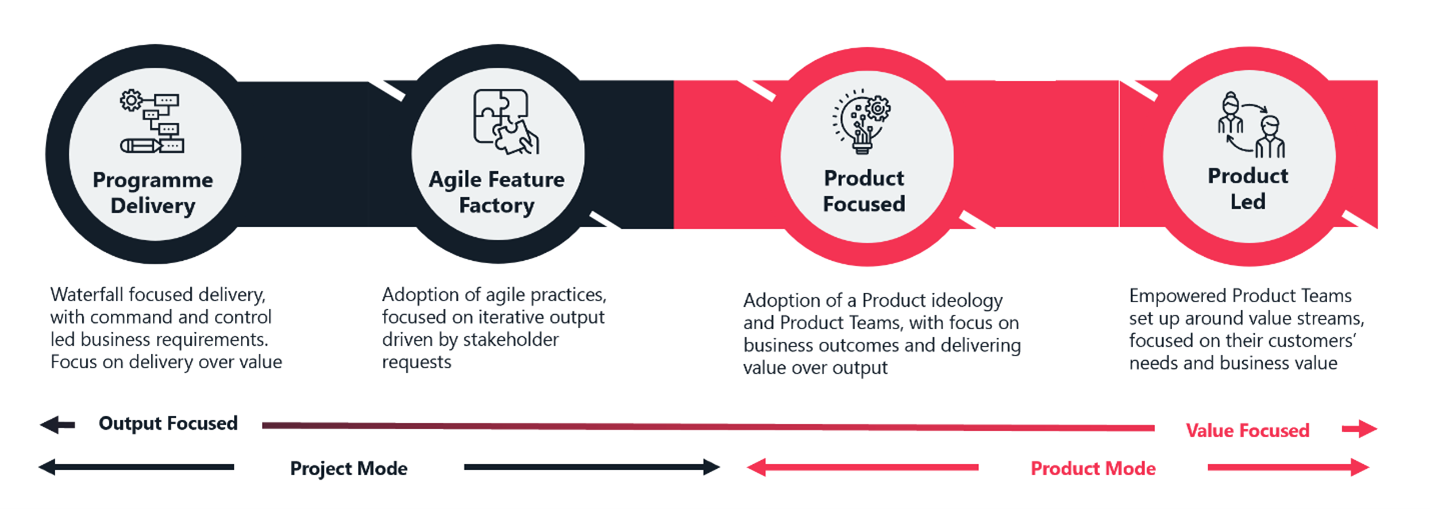A product mindset is focused on closely integrating the business and IT together, focusing on customer needs and business impact, while using agile practices to deliver value for the business rapidly.
We recently explored The Evolution of IT: From Projects to Products. We’re now turning our attention to the benefits of shifting to a product mindset and how to do this in practice.
If you haven’t seen our previous article yet, take a read to understand why businesses are moving from a project-centric to a product-led approach.

How will a product approach benefit your organisation?
Increased business impact. By shifting to a product model, your team can focus on outcomes over features, looking at the best way to move the dial on their objectives, not just delivering ‘more’.
Higher productivity. By using agile methods and tooling, your team can increase their work flow and identify waste in the system (while delivering quickly).
Better customer value. The customer is at the heart of everything with a product mindset. Your team will develop solutions that deliver real value and address customer challenges.
Opportunities to innovate. By empowering your team and giving them clear strategic direction, they can try new things and innovate – without the layers of bureaucracy slowing them down or project milestones to stick to.
Focused on long-term adoption. With your team accountable for end-to-end delivery, products are built for the end user, with a focus on adoption and longevity in mind.
Increased team motivation. With your team feeling responsible for their product, they will likely be more engaged than their project counterparts.
And the result? “The top 20% most effective organizations are 3.2 times more likely to use product teams that are measured on business outcomes than those who do not.”1
How to start a seamless transition?
Transitioning to a product model can be complicated, but learning from others can help you confidently navigate common challenges. Success starts with shifting funding to focus on outcomes rather than outputs, ensuring teams are motivated by the value they create.
A customer-centric approach is key – embedding customer needs at the heart of product strategy leads to impactful features that drive business success. Following the entire product lifecycle is crucial, as well as maintaining ownership and accountability from inception to delivery. Leveraging data and insights to measure outcomes ensures informed decision-making and continuous improvement. With these recommendations, the transition can be seamless, strategic and customer-focused.
CASE STUDY Motability Operations
Motability Operation’s technology team recently adopted an agile model to continue improving their digital capabilities. Along with overspending, they were struggling to demonstrate real value. Teams were not working together, delivering features without considering customer needs.
They needed to shift their organisation to bring the business and IT together, focusing on customer needs and business impact. They needed a product approach.
The business piloted a bold operating model organised around value streams and business needs, refocussing governance and empowering teams.
The transformation delivered significant financial savings and is expected to achieve £multi-million savings – including over 6% of the technology budget – in the first year. Non-financial and efficiency benefits include increased speed to market, improved flow metrics through new ways of working and automation, more capacity for the team to focus on value-add work, and greater data literacy across the organisation. Motability Operations is also benefitting externally from improved customer engagement, satisfaction, digital touchpoints and accessibility, and internally from better employee engagement and satisfaction.
Your journey to product centricity
Moving to a product model can appear daunting at first. However, taking the process in stages will make the transition easier.
- Gain business and technology buy-in. The product model hinges on technology and business teams working together as one. Both sides need to be bought into the model and the benefits it can have
- Understand your goal. Focus on the business and customer impact you want to have, setting a north star and shaping your teams around clear objectives.
- Organise around impact, not technology. Build your product teams around impact to enable focus on a common mission.
- Build empowered cross-functional teams. Integrate key roles into single cross-functional teams, build a strong team identity and break down the ‘us and them’ mentality.
- Develop talent. Build a team that really understands the business, customers and outcomes to achieve.
- Pilot to build momentum, then scale at speed. Start small with a high-profile and impactful pilot, and use it to build buy-in across the organisation. Make sure you avoid ‘pilot purgatory’ – multiple pilots working inconsistently – and instead design and build a consistent model across the organisation.
By establishing the foundations and selecting pilots to prove the value, your organisation can rapidly accelerate the transition to product, leapfrogging ahead of your competitors and ensuring business impact from the start.
A competitive edge
Adopting a product mindset marks a significant shift for organisations, aligning business and IT to deliver measurable outcomes, innovation, and customer value. While the transition may seem challenging, taking a structured approach—gaining buy-in, setting clear objectives, building empowered teams, and piloting strategically—can ensure success.
The benefits of a product-centric approach are clear: it’s a transformative model that positions your business for sustained growth and competitive advantage.
1 Source: Gartner®, 2024 Strategic Roadmap for CIOs to Deliver Digital Products and Services, Brandon Germer, Erin Neus-Cheong, 19 June 2024
Disclaimers and attribution
GARTNER is a registered trademark and service mark of Gartner, Inc. and/or its affiliates in the U.S. and internationally and is used herein with permission. All rights reserved.
We’re passionate about helping businesses transform in ways that that position them for sustained growth and competitive advantage.

